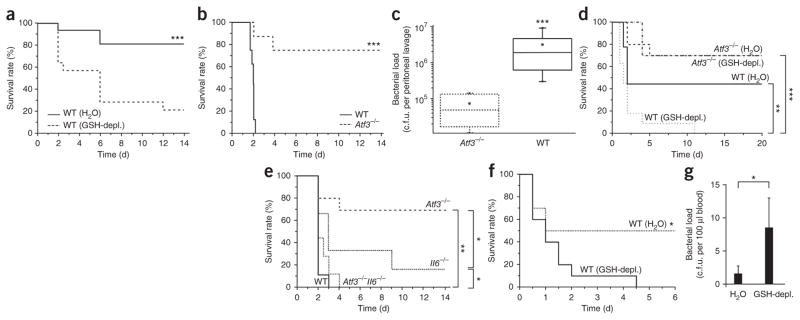Figure 5.

ROS-induced ATF3 causes high susceptibility to bacterial peritonitis and E. coli sepsis by suppressing IL-6. (a) Mortality of wild-type (WT) mice (littermates) fed either DMF (GSH-depl.) or water for 10 d and subjected to mild CLP. Data represent four independent experiments (n = 8 mice per group per experiment). (b) Mortality of WT or Atf3−/− mice after severe CLP. Data represent three independent experiments (n = 6–8 mice per group per experiment). (c) Bacterial load measured by peritonial lavage in WT or Atf3−/− mice 24 h after CLP. Data represent two independent experiments (n = 5 mice per group per experiment). (d) Mortality after intermediate CLP of WT or Atf3−/− mice treated with water or DMF, as in a. Data represent two independent experiments (n = 9 or 10 mice per group per experiment). (e) Mortality of WT, Atf3−/−, Il6−/−, and Atf3−/−Il6−/− mice after CLP. Data represent two independent experiments (n = 9 or 10 mice per group per experiment). (f,g) Mortality of WT mice (littermates) fed DMF (GSH-depl.) or water for 10 d then challenged with E. coli intraperitoneally (1 × 1010 c.f.u.) and treated with antibiotics as described in Online Methods. Data represent two independent experiments (n = 5–6 mice per group per experiment). (g) Bacterial load in blood of mice in f, 24 h after E. coli injection (n = 6 mice per group; data are means ± s.d.). *P < 0.05; **P < 0.01; ***P < 0.001 (t test (c) or log-rank statistic).
